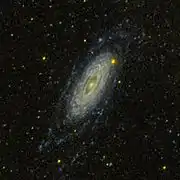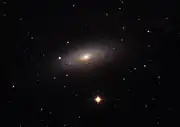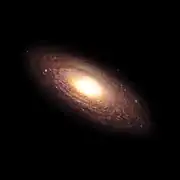NGC 2841
NGC 2841 is an unbarred spiral galaxy in the northern circumpolar constellation of Ursa Major. It was discovered on 9 March 1788 by German-born astronomer William Herschel. J. L. E. Dreyer, the author of the New General Catalogue, described it as, "very bright, large, very much extended 151°, very suddenly much brighter middle equal to 10th magnitude star".[7] Initially thought to be about 30 million light-years distant, a 2001 Hubble Space Telescope survey of the galaxy's Cepheid variables determined its distance to be approximately 14.1 megaparsecs or 46 million light-years.[4] The optical size of the galaxy is 8.′1 × 3.′5.[6]
| NGC 2841 | |
|---|---|
 Hubble image of NGC 2841 | |
| Observation data (J2000 epoch) | |
| Constellation | Ursa Major |
| Right ascension | 09h 22m 02.655s[1] |
| Declination | +50° 58′ 35.32″[1] |
| Redshift | 0.002130[2] |
| Helio radial velocity | 638 km/s[3] |
| Distance | 46.0 ± 4.9 Mly (14.1 ± 1.5 Mpc)[4][5] |
| Apparent magnitude (V) | 10.1[3] |
| Characteristics | |
| Type | SAa[2] |
| Mass | 7×1010 M☉[6] M☉ |
| Apparent size (V) | 8.′1 × 3.′5[6] |
| Notable features | Flocculent galaxy with LINER nucleus |
| Other designations | |
| UGC 4966, PGC 26512[3] | |
This is the prototype for the flocculent spiral galaxy,[5] a type of spiral galaxy whose arms are patchy and discontinuous.[8] The morphological class is SAa, indicating a spiral galaxy with no central bar and very tightly-wound arms. There is no grand design structure visible in the optical band, although some inner spiral arms can be seen in the near infrared.[5] It is inclined by an angle of 68° to the line of sight from the Earth, with the major axis aligned along a position angle of 148°.[5]
The properties of NGC 2841 are similar to those of the Andromeda Galaxy.[4] It is home to a large population of young blue stars, and a few H II regions.[9] The luminosity of the galaxy is 2×1010 M☉ and it has a combined mass of 7×1010 M☉.[6] Its disk of stars can be traced out to a radius of around 228 kly (70 kpc). This disk begins to warp at a radius of around 98 kly (30 kpc), suggesting the perturbing effect of in-falling matter from the surrounding medium.[5]
The rotational behavior of the galaxy suggests there is a massive nuclear bulge,[6] with a low-ionization nuclear emission-line region (LINER) at the core; a type of region that is characterized by spectral line emission from weakly ionized atoms.[10] A prominent molecular ring is orbiting at a radius of 7–20 kly (2–6 kpc), which is providing a star-forming region of gas and dust.[6] The nucleus appears decoupled and there is a counter-rotating element of stars and gas in the outer parts of the nucleus, suggesting a recent interaction with a smaller galaxy.[6]
Gallery
 Image taken by the Hubble Space Telescope
Image taken by the Hubble Space Telescope GALEX image of NGC 2841
GALEX image of NGC 2841 SDSS image of NGC 2841
SDSS image of NGC 2841 Mount Lemmon Observatory image of the spiral galaxy NGC 2841
Mount Lemmon Observatory image of the spiral galaxy NGC 2841 A view of NGC 2841 by ESA/Hubble Collaboration. Unrelated objects have been edited out
A view of NGC 2841 by ESA/Hubble Collaboration. Unrelated objects have been edited out
References
- Skrutskie, M. F.; et al. (February 2006). "The Two Micron All Sky Survey (2MASS)". The Astronomical Journal. 131 (2): 1163–1183. Bibcode:2006AJ....131.1163S. doi:10.1086/498708.
- Ann, H. B.; et al. (2015). "A Catalog of Visually Classified Galaxies in the Local (z ∼ 0.01) Universe". The Astrophysical Journal Supplement Series. 217 (2): 27. arXiv:1502.03545. Bibcode:2015ApJS..217...27A. doi:10.1088/0067-0049/217/2/27. S2CID 119253507.
- "NASA/IPAC Extragalactic Database". Results for NGC 2841. Retrieved 2006-10-04.
- Macri, L. M.; Stetson, P. B.; Bothun, G. D.; Freedman, W. L.; et al. (September 2001). "The Discovery of Cepheids and a New Distance to NGC 2841 Using the Hubble Space Telescope". Astrophysical Journal. 559 (1): 243–259. arXiv:astro-ph/0105491. Bibcode:2001ApJ...559..243M. doi:10.1086/322395. ISSN 0004-637X. S2CID 15546458.
- Zhang, Jielai; et al. (March 2018). "The Dragonfly Nearby Galaxies Survey. IV. A Giant Stellar Disk in NGC 2841". The Astrophysical Journal. 855 (2): 8. arXiv:1802.02583. Bibcode:2018ApJ...855...78Z. doi:10.3847/1538-4357/aaac81. S2CID 58889554. 78.
- Kaneda, H.; et al. (October 2007). "Far-Infrared Distributions in Nearby Spiral Galaxies NGC 2841 and NGC 2976 Observed with AKARI/Far-Infrared Surveyor (FIS)". Publications of the Astronomical Society of Japan. 59 (s2): S463. arXiv:0706.0068. Bibcode:2007PASJ...59S.463K. doi:10.1093/pasj/59.sp2.S463. S2CID 17966955.
- Seligman, Courtney. "NGC Objects: NGC 2800 - 2849". Celestial Atlas. Retrieved 2016-03-01.
- Elmegreen, Debra. A Near-Infrared Atlas of Spiral Galaxies. Retrieved 23 April 2010. See CH3. Discussion.
- Marochnik, Leonid; Suchkov, Anatoly (1995-11-01). Milky Way Galaxy (1st ed.). Routledge. p. 267. ISBN 978-2-88124-931-0.
- Ho, L. C.; et al. (1997). "A Search for "Dwarf" Seyfert Nuclei. III. Spectroscopic Parameters and Properties of the Host Galaxies". Astrophysical Journal Supplement. 112 (2): 315–390. arXiv:astro-ph/9704107. Bibcode:1997ApJS..112..315H. doi:10.1086/313041. S2CID 17086638.
External links
| Wikimedia Commons has media related to NGC 2841. |
- NGC 2841 on WikiSky: DSS2, SDSS, GALEX, IRAS, Hydrogen α, X-Ray, Astrophoto, Sky Map, Articles and images